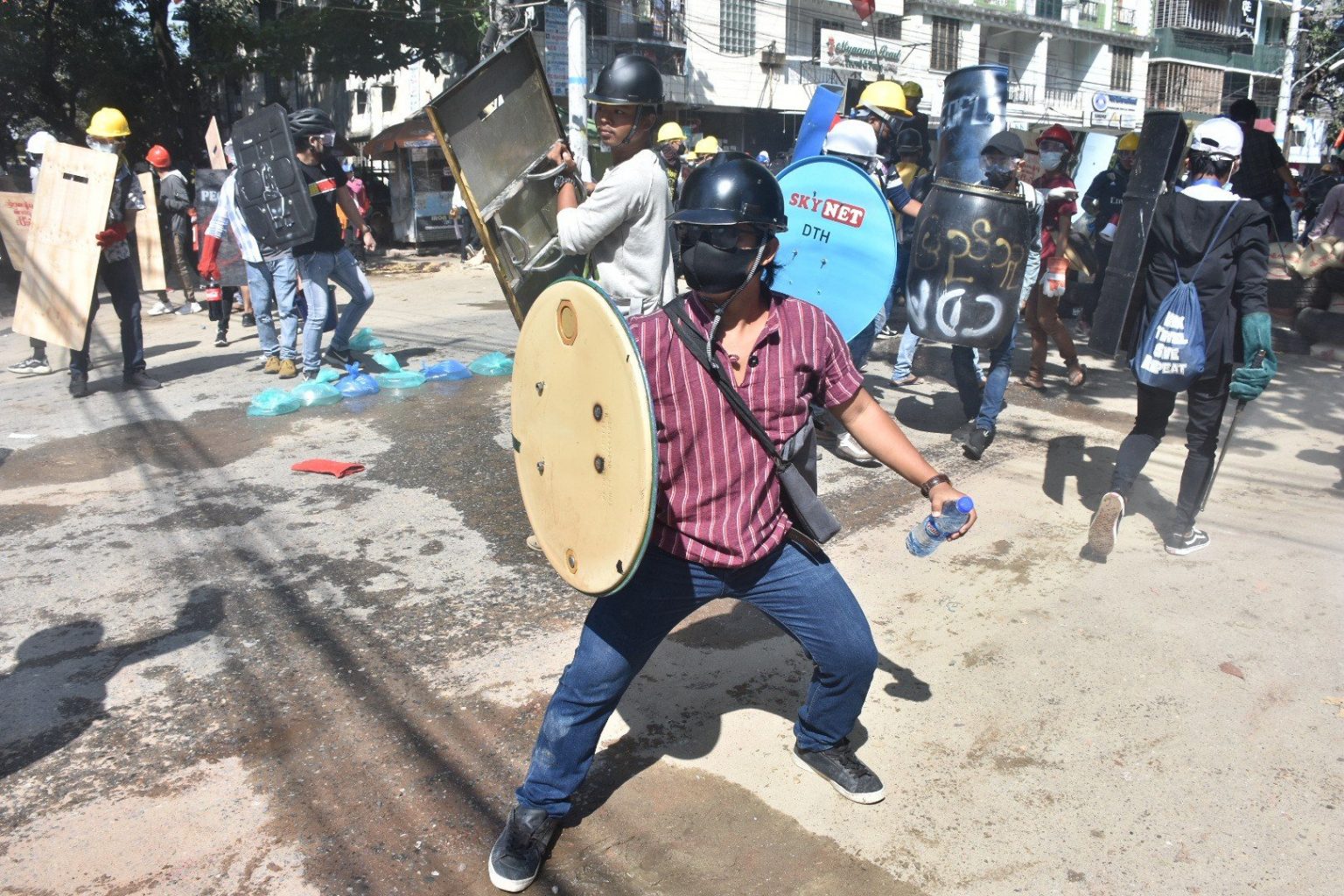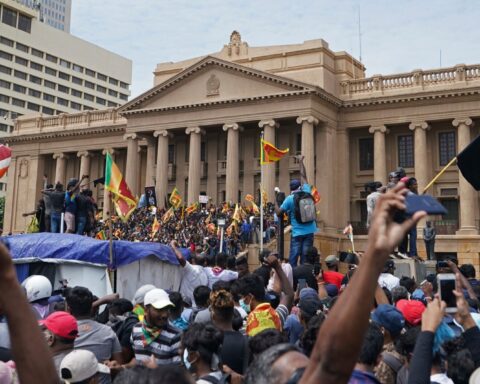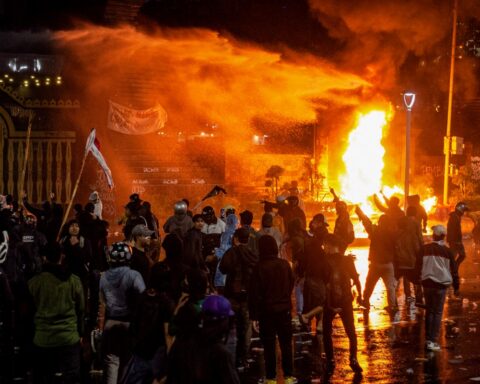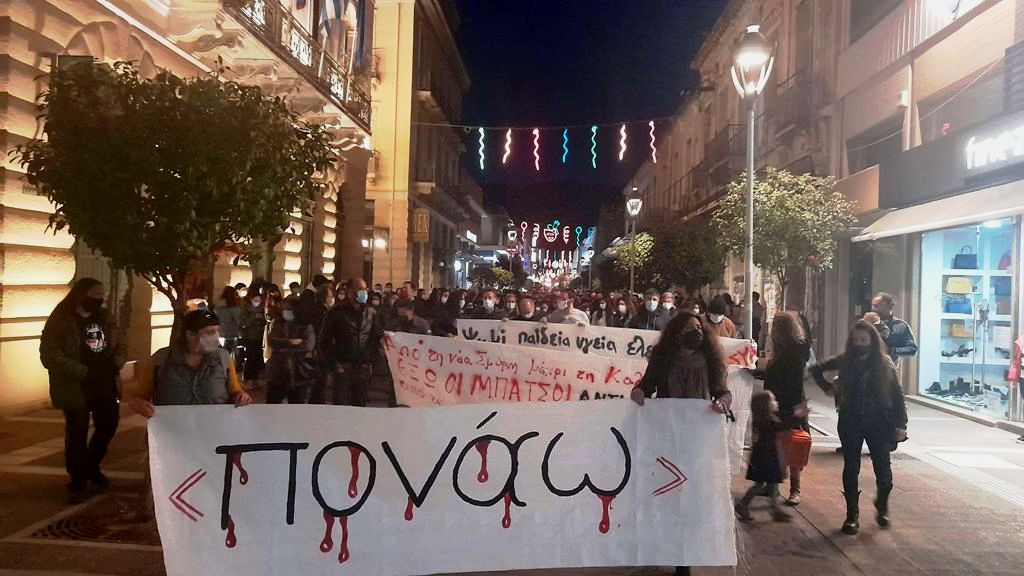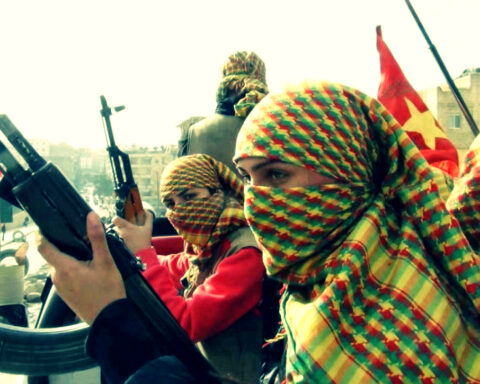Ko Kyaw Htet is a frontline member of a protest group that has been gathering each day in Yangon’s Sanchaung Township for several weeks.
The 23-year-old, who like every other protester in this article has been given a pseudonym for their safety, uses a shield fashioned from a SkyNet satellite dish for protection against rubber bullets. The activist also wears a yellow plastic hardhat and goggles to protect his eyes from tear gas and smoke.
“We are frontliners. We know that we can be arrested or killed by live rounds when the soldiers shoot at us, but we have to protect our friends,” he said.
While the early street protests against the February 1 military takeover remained largely peaceful, attracting people from all strata of society, the police and army have violently broken up more recent demonstrations, killing more than 70 so far. This has whittled down protests to younger, more daring groups engaging in cat-and-mouse games with security forces: making tactical retreats and reassembling the moment forces move on. To avoid death, injury or arrest, they have had to quickly adopt new methods and tools.
Mayangone Township resident Ko Phyo Tin, 25, who joins the Kyun Taw protest group every day, uses a shield improvised from a piece of steel as protection against rubber bullets and live rounds, and dons a Chinese-made combat helmet.
“Most of us are using protective equipment made in China. We don’t trust its quality but we have no alternative,” he said, adding that the group would gladly accept donations of quality gas masks, hard hats and body armour.
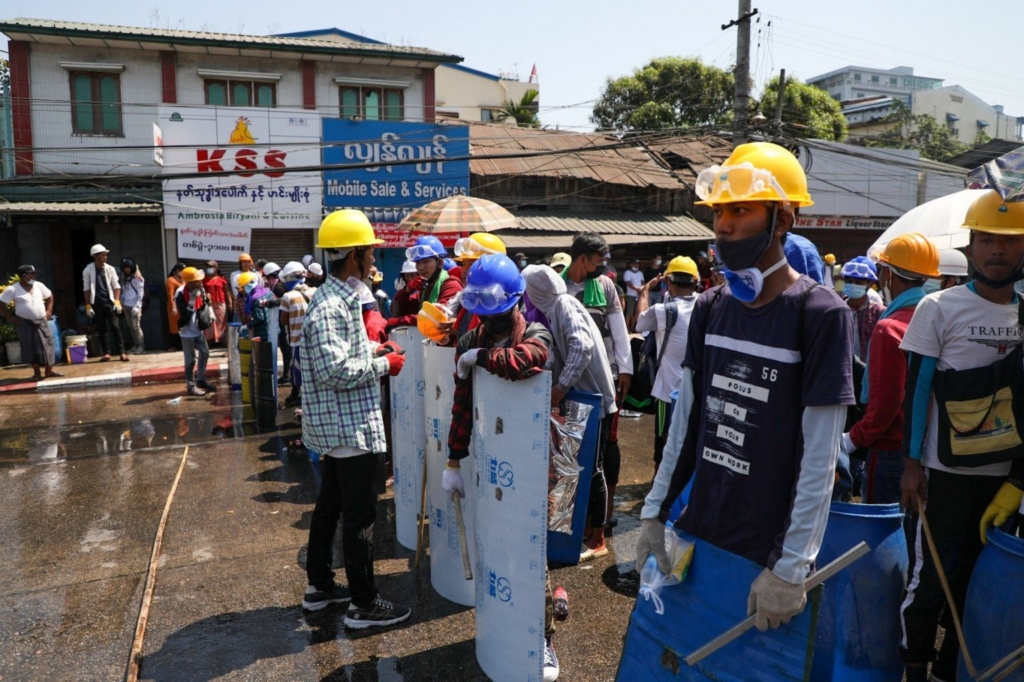
Women have also taken up positions as “frontliners”, the protesters bearing the brunt of the police and army assaults and shielding those behind them. They include Ma Thu Thu, 23, a founder of a team of frontliners that operates in Hlaing and Kamaryut townships, where such groups proliferate.
Thu Thu said her team comprises a core group of more than 10 people that is supported by about another 50 volunteers, who have learned from the street tactics used in dissident movements overseas.
“I saw the protests in Hong Kong and they gave me ideas about how we could defend ourselves,” said Thu Thu, whose small frame belies a capacity to endure gruelling confrontations with security forces.
She has been protesting against military rule since February 6 and is increasingly convinced that the people need protection from the lethal force police and soldiers used against striking dockworkers in Mandalay on February 20, when security forces fired live rounds on a crowd of more than 1,000 demonstrators at a shipyard, killing two and injuring dozens.
On February 26, Thu Thu watched a violent crackdown by police on big crowds of protesters at the Myanigone and Hledan junctions in Yangon.
“Police opened fire to disperse protesters, who fled in chaos. Some were arrested. When I saw that, I thought we needed to be able to protect protesters during demonstrations planned for February 28, Milk Tea Alliance Day,” she said, referring to a loose alliance of pro-democracy movements in Thailand, Hong Kong, Taiwan and now Myanmar.
“I posted [these thoughts] on Facebook and one of my friends said she would donate 30 shields. I talked with some of my male friends and we decided to volunteer as frontliners,” she added.
“When we first started posting [about our plan], about a hundred people contacted us [wanting to join]. Members of our group are from many different townships in Yangon.”
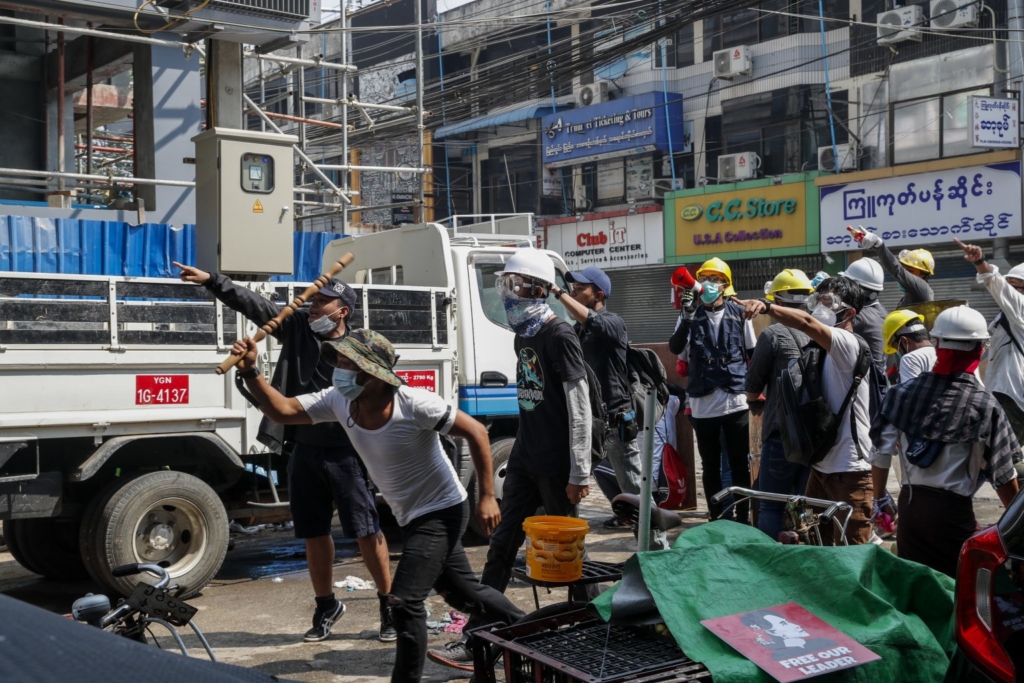
Retaking the streets
On Milk Tea Alliance Day, the group had intended to use wooden shields to defend protesters at Hledan junction, but the police and army opened fire with rubber bullets and some live rounds before Thu Thu and her team arrived, killing two kill people.
Hearing this, they discussed whether to abandon their plan, knowing that their wooden shields weren’t bullet-proof, but they decided they had a duty to protect other protesters no matter what. They took their positions at the frontline and, fortunately, police did not open fire again that day at Hledan.
The next day, they turned to homemade remedies when tear gas was thrown at protesters on a section of Insein Road, near the Butaryone bus stop in Hlaing Township.
“[At first] we suffered a lot from the tear gas so we each carried with us a can of Coca-Cola, […] prepared bags of water and wore towels around our necks,” Thu Thu said, explaining that because “many gas masks on the market are useless against tear gas”, protesters learned to douse their faces with liquid or apply a wet towel instead.
“We also switched our wooden shields for steel shields,” she said, describing how the group created a front line of shield-carriers called the “Tank” group – a reference to a battle role taken in online smartphone game Mobile Legends, which is popular among youth across Southeast Asia.
Behind the Tank is a group charged with countering tear gas volleys, including by smothering the discharging cannisters with bags of water and soaked pieces of cloth, and in some cases by dousing the cannisters with a fire extinguisher.
The frontline groups also try to erect two makeshift barriers to separate security forces from protesters.
“We need two so that when police destroy the first we can fall back to the second,” Thu Thu said, adding that they had improvised the strategy themselves.
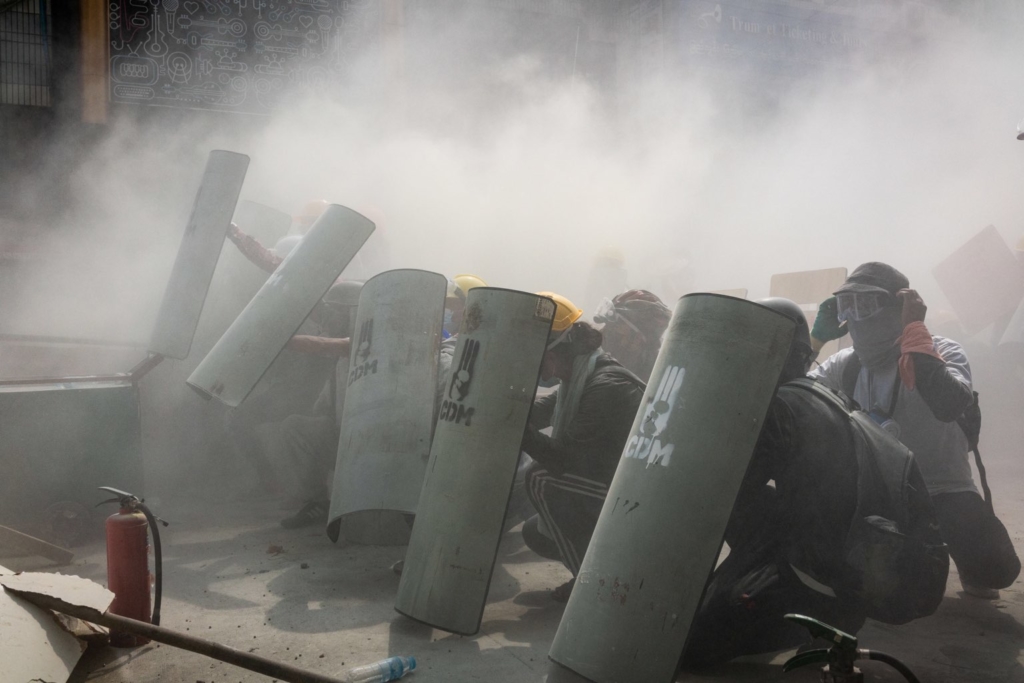
Despite the police and army’s use of brute force, she said experience had taught the protesters that they “needed brave people more than physically strong people” to serve on the front line.
“At first, we chose the physically strong, but when police started shooting, they ran away,” she said, laughing. “In our Tank group none of the men are taller than five feet eight inches.”
“When we end a day and both the frontline defenders and ordinary protesters are okay, we regard that as a victory,” Thu Thu said, adding that they found it hard to forgive themselves whenever a protester was hurt or arrested. “We think about it until late at night. Sometimes I cry.”
Frontliners told Frontier they are not scared of the police, but if soldiers are deployed, they flee.
“If it’s just tear gas, rubber bullets or stun grenades, we aren’t afraid. But we are afraid of real bullets. That’s why we switched to steel shields,” Thu Thu said, though conceded that even those may not protect them from live rounds. This was proved on March 11, when a protester in Yangon’s North Dagon Township died when a bullet penetrated his makeshift metal shield.
While the security forces have been unable to break the resolve of protest groups like Thu Thu’s, they have increasingly cleared them from the main roads and junctions and pushed them into residential lanes. This has allowed them to hide in the apartments of supportive residents during crackdowns, but it’s also put those residents and their homes in danger. On March 10, police in Sanchaung began raiding the apartments of people suspected of sheltering protesters.
Thu Thu said this risk to ordinary city residents made it more important for protesters to reoccupy the major roads.
“On March 1 and 2, we can say that we won; the protesters owned Insein Road,” she said, referring to the major thoroughfare. “But then police fired tear gas and bullets and destroyed our barricades, so people became too afraid to protest on the main roads.”
Some want to protest from what they think is the relative safety of their living rooms, Thu Thu said, but if they do that, “police will shoot into their homes”. That’s one reason she said she wants to see more people out on the streets.
“I believe that a revolution is not won without bloodshed, but as long as the protesters are on the streets, we will help to defend them,” she said, adding that frontliners are thinking hard about ways to offer more protection so that “the people have the courage to go back out”.
“If we do not get back on the main roads, we will lose,” she said. “There are about seven million people in Yangon; if they all take to the streets it will not be easy for the police to crack down on them.”
The frontliners know they are risking arrest, and even death. Thu Thu said she had told her friends, “If I die, please give everything I have to my parents.”
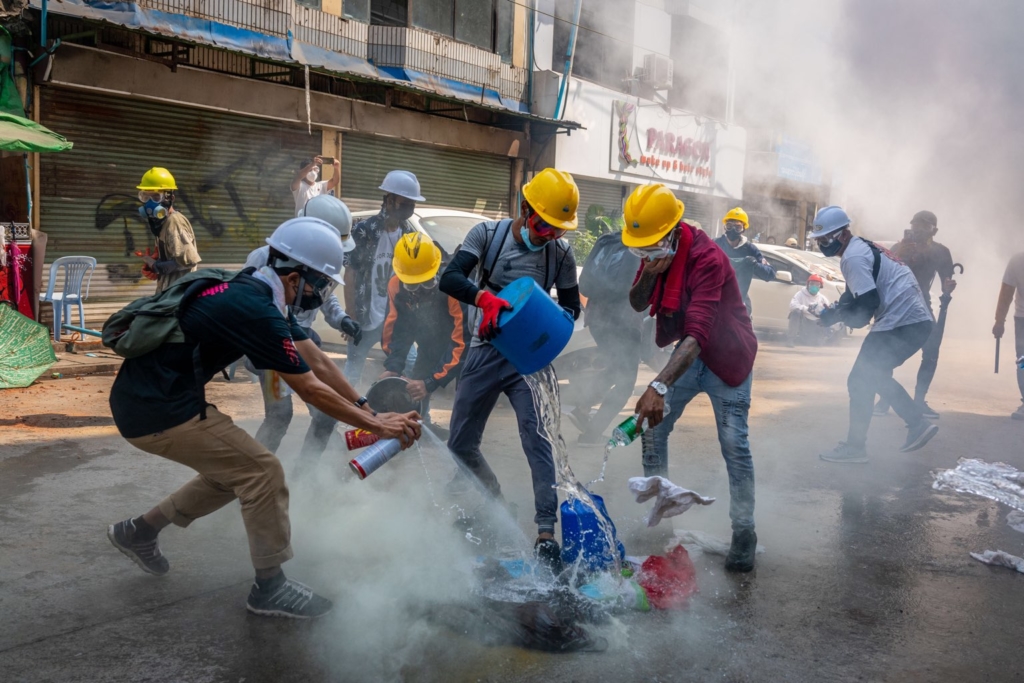
‘We know we are risking our lives’
Hlaing resident Ko Thiha, 22, is a frontliner active in his township. He wears a red flannel shirt and carries a steel shield that he hits with a short length of plastic pipe as he and other frontliners chant, “The revolution must win!”
He said the first time he served as a frontliner at the junctions of Baho and Hlaing River roads on March 2, he was both excited and scared. “Now, I am more confident,” he told Frontier three days later.“We ask the protesters to stay behind us and not be afraid because we will protect them from the riot police.”
When army units advance, he said, the instructions are different: “run”.
Thiha and his friends learned their tactics, including the use of metal shields, from watching other protest groups in Yangon. They’ve also drawn inspiration from the Hong Kong uprising, where protesters erected barricades, used homemade shields, wore hard hats and found inventive ways to neutralise tear gas cannisters.
But Thiha’s group has also claimed their own innovations. “We make the shields ourselves using polished steel, meaning we can also use them to reflect sunlight onto the eyes of police when they are advancing towards us,” he said proudly. “This was our idea.”
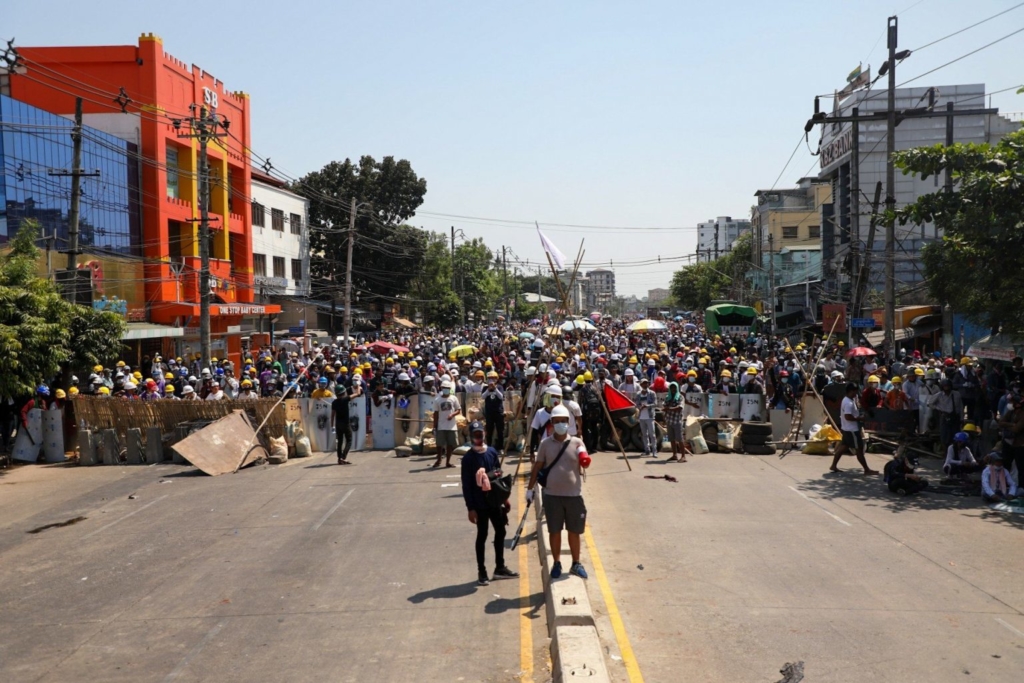
Thiha, who said he had also watched a documentary about the so-called Revolution of Dignity in Ukraine that began in November 2013 and took 91 days to overthrow an oppressive regime, said the steel shields only protected against rubber bullets that police use. “If soldiers are involved, we must run – they use live rounds,” he said.
He also acknowledged that his hard hat and cheap gas mask offer little protection against rubber bullets or tear gas at close range, but are still better than nothing.
“We know we’re risking our lives, but we must protect peaceful protesters. That’s why I decided to join the front line,” he said.
“They can arrest, injure or kill us, but if we get democracy, it all will have been worth it.”
___________
source+ more info: FRONTIER / Myanmar- Independent Journalism
